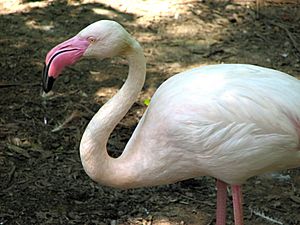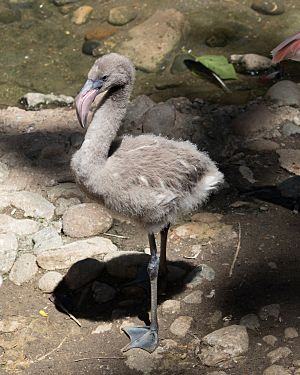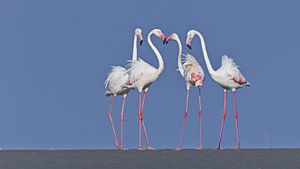Greater flamingo facts for kids
Quick facts for kids Greater flamingo |
|
|---|---|
 |
|
| Greater flamingo at the Cincinnati Zoo | |
| Conservation status | |
| Scientific classification | |
| Kingdom: | |
| Phylum: | |
| Class: | |
| Order: |
Phoenicopteriformes
|
| Family: | |
| Genus: | |
| Binomial name | |
| Phoenicopterus roseus |
|
The greater flamingo (Phoenicopterus roseus) is the most common type of flamingo. You can find it in wet areas like wetlands across Africa, southwest Europe, and South Asia. This is the biggest flamingo species. It can grow up to 5 feet (1.5 meters) tall and weigh around 8 pounds (3.6 kg). Its wings can spread 4 to 6 feet wide. In the wild, greater flamingos can live for about 20 years. They eat seeds, algae, and tiny water creatures.
Contents
What Does a Greater Flamingo Look Like?
This is the largest type of flamingo. It usually stands about 110 to 150 centimeters (43 to 59 inches) tall. It weighs between 2 and 4 kilograms (4.4 to 8.8 pounds). The biggest male flamingos can be as tall as 187 centimeters (74 inches) and weigh up to 4.5 kilograms (9.9 pounds). This bird is very similar to the American flamingo and Chilean flamingo.
Like all flamingos, the greater flamingo lays just one chalky-white egg. They lay it on a tall mound of mud. Most of their feathers are a pinkish-white color. However, the feathers under their wings are red. Their main flight feathers are black. Their bill is pink with a black tip. Their legs are completely pink. When they call out, it sounds like a goose honking.
Young flamingos, called subadults, are whitish-gray. They only get their famous pink color after several years. This pink color comes from special pigments called carotenoids. These pigments are found in the tiny plants and animals they eat.
Flamingos also have a special gland called the uropygial gland. This gland makes an oily liquid that also contains carotenoids. During the time they breed, greater flamingos spread more of this liquid on their feathers. This makes their color brighter! It's almost like they are putting on "make-up" to look their best.
Where Do Greater Flamingos Live and What Do They Eat?
These birds live in mudflats and shallow lagoons near the coast. They prefer areas with salt water. To find food, a flamingo uses its feet to stir up the mud. Then, it sucks water through its bill. Its bill acts like a filter, catching small shrimp, seeds, blue-green algae, tiny organisms, and mollusks.
The greater flamingo feeds with its head upside down. Its upper jaw can move, which is unusual for a bird. It is not stuck firmly to its skull.
You can find greater flamingos in parts of Africa and southern Asia. This includes countries like Bangladesh, Pakistan, India, and Sri Lanka. They also live in the Middle East, in places like Turkey, Israel, and the United Arab Emirates. In southern Europe, they are found in Spain, Greece, Italy, and France. The most northern place they breed is in western Germany.
In the state of Gujarat, India, you can see flamingos at several bird sanctuaries. They stay there throughout the winter.
How Long Do Greater Flamingos Live?
In zoos, greater flamingos can live for a very long time. For example, at Zoo Basel, they often live for over 60 years.
Greater Flamingos and Humans
Flamingos in Zoos
The first greater flamingo chick to hatch in a zoo was in 1959 at Zoo Basel. This zoo has a special breeding program. They have hatched over 400 flamingo chicks there. Since the year 2000, they have hatched between 20 and 27 chicks each year.
The oldest known greater flamingo was named "Greater." He lived at the Adelaide Zoo in Australia. He was at least 83 years old when he passed away. We don't know his exact age, but he was already an adult when he arrived at the zoo in 1933. He was put to sleep in January 2014 because of problems from being so old.
What Threats Do Flamingos Face?
Adult flamingos do not have many natural predators. The biggest dangers to flamingo groups are bacteria, toxins, and pollution in their water. This pollution often comes from factories. Another threat is when human development takes over their habitat, which is the natural place where they live.
Images for kids
-
An egg at the Cincinnati Zoo
-
Adult flamingos at the Albufera de Valencia lagoon, Spain
-
Flamingos resting with their heads down in Bahrain
See also
 In Spanish: Flamenco común para niños
In Spanish: Flamenco común para niños












